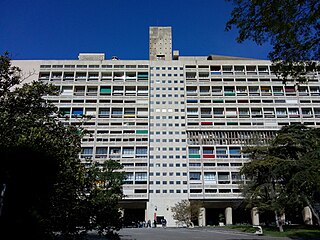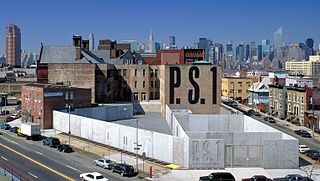
The Museum of Modern Art (MoMA) is an art museum located in Midtown Manhattan, New York City, on 53rd Street between Fifth and Sixth Avenues. The institution was conceived in 1929 by Abby Aldrich Rockefeller, Lillie P. Bliss, and Mary Quinn Sullivan. Initially located in the Heckscher Building on Fifth Avenue, it opened just days after the Wall Street Crash. The museum, America's first devoted exclusively to modern art, was led by A. Conger Goodyear as president and Abby Rockefeller as treasurer, with Alfred H. Barr Jr. as its first director. Under Barr's leadership, the museum's collection rapidly expanded, beginning with an inaugural exhibition of works by European modernists. Despite financial challenges, including opposition from John D. Rockefeller Jr., the museum moved to several temporary locations in its early years, and John D. Rockefeller Jr. eventually donated the land for its permanent site.

De Stijl, incorporating the ideas of Neoplasticism, was a Dutch art movement founded in 1917 in Leiden, consisting of artists and architects. The term De Stijl is also used to refer to a body of work from 1917 to 1931 created in the Netherlands. Proponents of De Stijl advocated pure abstraction and universality by a reduction to the essentials of form and colour. They simplified visual compositions to vertical and horizontal, using only black, white and primary colors.

The International Style is a major architectural style and movement that began in western Europe in the 1920s and dominated modern architecture until the 1970s. It is defined by strict adherence to functional and utilitarian designs and construction methods, typically expressed through minimalism. The style is characterized by modular and rectilinear forms, flat surfaces devoid of ornamentation and decoration, open and airy interiors that blend with the exterior, and the use of glass, steel, and concrete.

Modern architecture, also called modernist architecture, was an architectural movement and style that was prominent in the 20th century, between the earlier Art Deco and later postmodern movements. Modern architecture was based upon new and innovative technologies of construction ; the principle functionalism ; an embrace of minimalism; and a rejection of ornament.

The Unité d'habitation is a modernist residential housing typology developed by Le Corbusier, with the collaboration of painter-architect Nadir Afonso. It formed the basis of several housing developments throughout Europe designed by Le Corbusier and sharing the same name.

Vernacular architecture is building done outside any academic tradition, and without professional guidance. It is not a particular architectural movement or style, but rather a broad category, encompassing a wide range and variety of building types, with differing methods of construction, from around the world, both historical and extant and classical and modern. Vernacular architecture constitutes 95% of the world's built environment, as estimated in 1995 by Amos Rapoport, as measured against the small percentage of new buildings every year designed by architects and built by engineers.

Yoshio Taniguchi is a Japanese architect best known for his redesign of the Museum of Modern Art in New York City, which was reopened November 20, 2004. Critics have emphasized Taniguchi's fusion of traditional Japanese and Modernist aesthetics. Martin Filler, writing in The New York Times, praised "the luminous physicality and calm aura of Taniguchi's buildings," noting that the architect "sets his work apart by exploiting the traditional Japanese strategies of clarity, understatement, opposition, asymmetry and proportion." "In an era of glamorously expressionist architecture," wrote Time critic Richard Lacayo, MoMA "has opted for a work of what you might call old-fashioned Modernism, clean-lined and rectilinear, a subtly updated version of the glass-and-steel box that the museum first championed in the 1930s, years before that style was adopted for corporate headquarters everywhere."

MoMA PS1 is a contemporary art institution at 22-01 Jackson Avenue in the Long Island City neighborhood of Queens in New York City, United States. In addition to its exhibitions, the institution organizes the Sunday Sessions performance series, the Warm Up summer music series, and the Young Architects Program with the Museum of Modern Art. MoMA PS1 has been affiliated with the Museum of Modern Art since January 2000 and, as of 2013, attracts about 200,000 visitors a year.

Bernard Rudofsky was an Austrian American writer, architect, collector, teacher, designer, and social historian. His most notable work is Architecture Without Architects: A Short Introduction to Non-pedigreed Architecture, published in 1964. Ada Louise Huxtable called him “the master iconoclast of the modern movement."

Aino Maria Marsio-Aalto was a Finnish architect and a pioneer of Scandinavian design. She is known as the design partner of architect Alvar Aalto, with whom she worked for 25 years, and as a co-founder with him, Maire Gullichsen, and Nils-Gustav Hahl of the design company Artek, collaborating on many its most well-known designs. As Artek's first artistic director, her creative output spanned textiles, lamps, glassware, and buildings. Her work is in the permanent collection of the Museum of Modern Art (MoMA) in New York, and MoMA has included her work in nine exhibitions, the first of which was Aalto: Architecture and Furniture in 1938. Other major exhibitions were at the Barbican Art Gallery in London and Chelsea Space in London. Aino Aalto has been exhibited with Pablo Picasso.

Mario Bellini is an Italian architect and designer. After graduating from the Polytechnic University of Milan in 1959, Bellini pursued a career as an architect, exhibition designer, product designer, and furniture designer during the Italian economic boom of the late 20th century. Bellini has received several accolades in a variety of design fields, including eight Compasso d'Oro awards and the Gold Medal for Lifetime Achievement by the Triennale di Milano. In 2019, the Italian President of the Chamber of Deputies, Roberto Fico, awarded Bellini a career medal in recognition of his contributions to Italian architecture and design.
Storefront for Art and Architecture is an independent, non-profit art and architecture organization located in SoHo, Manhattan in New York City. The organization is committed to the advancement of innovative positions in architecture, art and design.

Deconstructivism is a postmodern architectural movement which appeared in the 1980s. It gives the impression of the fragmentation of the constructed building, commonly characterised by an absence of obvious harmony, continuity, or symmetry. Its name is a portmanteau of Constructivism and "Deconstruction", a form of semiotic analysis developed by the French philosopher Jacques Derrida. Architects whose work is often described as deconstructivist include Zaha Hadid, Peter Eisenman, Frank Gehry, Rem Koolhaas, Daniel Libeskind, Bernard Tschumi, and Coop Himmelb(l)au.

Nordic Classicism was a style of architecture that briefly blossomed in the Nordic countries between 1910 and 1930.
Bernardo Sandals was founded in 1946 by architect Bernard Rudofsky and Berta Rudofsky. The Rudofskys went into sandal design following the 1944 exhibition, "Are Clothes Modern?" that Mr. Rudofsky curated at the Museum of Modern Art in New York City.
Andreas Constantine Papadakis FLS was a Cypriot-born British academic, entrepreneur and leading figure in the field of architectural publishing. He opened the Academy Bookshop in Holland Street, Kensington, in 1964 and moved into publishing as Academy Editions in 1968. From then until 1990, when he sold the company to VCH Germany he published more than a thousand titles mainly on art, architecture and the decorative arts. He was the first to publish many international architects in the Architectural Monographs series, which included Alvar Aalto, Michael Graves, Edwin Lutyens, John Soane, Terry Farrell, Richard Rogers, Mies van der Rohe, Hassan Fathy, Tadao Ando, Daniel Libeskind, etc.; and Victor Arwas's Art Deco, first published in 1980, remains the standard work on the subject.
Albert Henry Hill was an American architect. Hill played a significant role in the development of the Second Bay Tradition architectural style.

Elizabeth (Bauer) Mock was director of the Department of Architecture and Design at the Museum of Modern Art (MoMA) and a university professor. She was a charter apprentice at Frank Lloyd Wright's Taliesin, and the first former Taliesin fellow to join the MoMA staff. She was an influential advocate for modern architecture in the United States.
Arthur Justin Drexler was an American museum curator and director of the Museum of Modern Art (MoMA) for 35 years.
Michelle Kuo is an American curator, writer, and art historian. Since 2018, Kuo has been a curator of painting and sculpture at the Museum of Modern Art. She was previously editor-in-chief of Artforum magazine starting in 2010.














